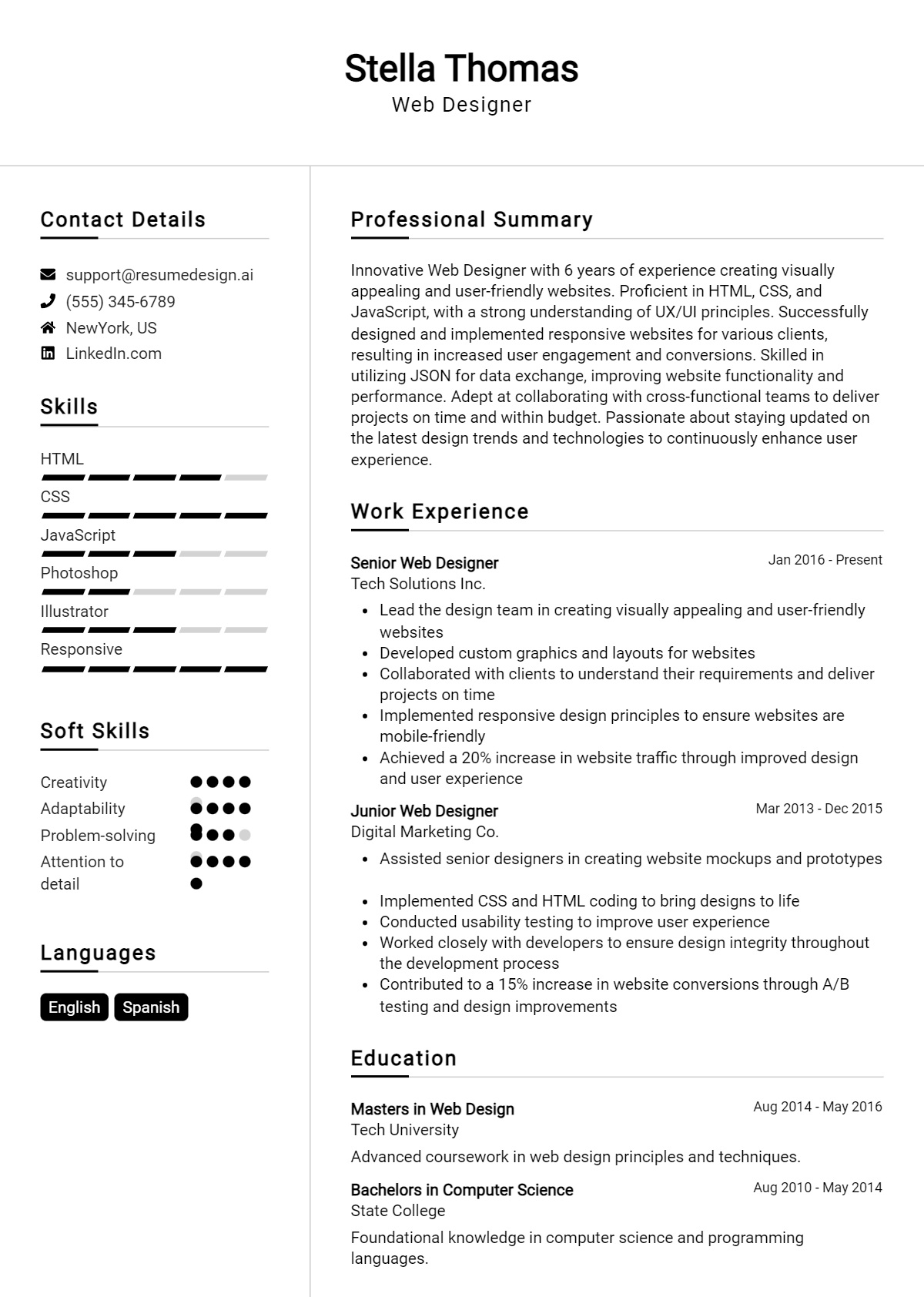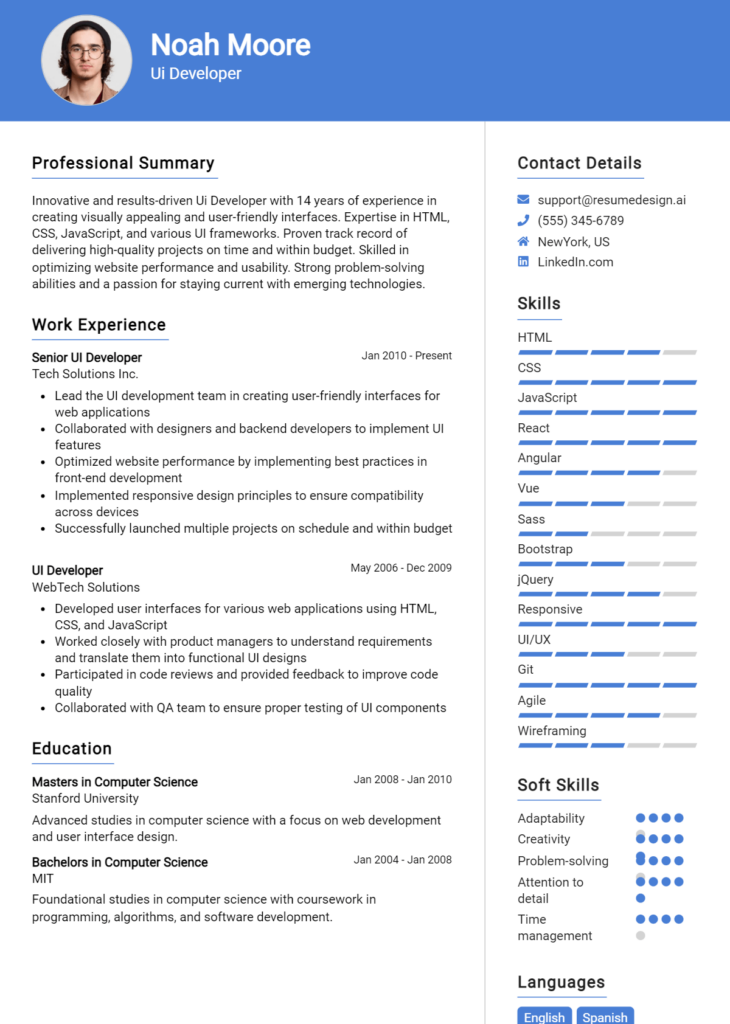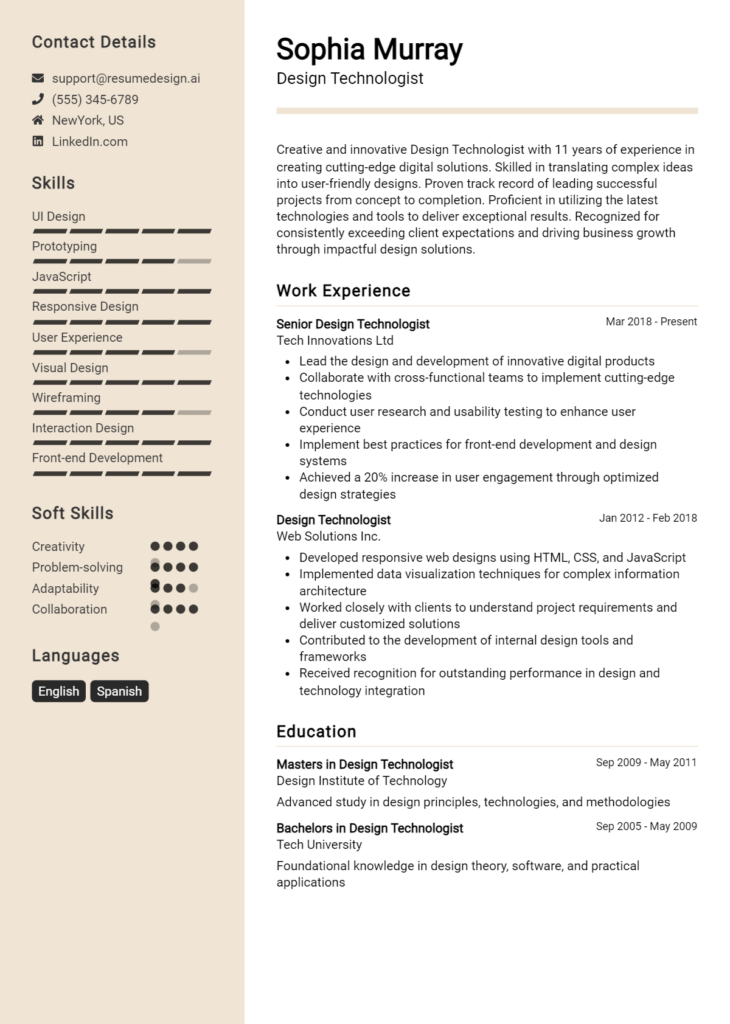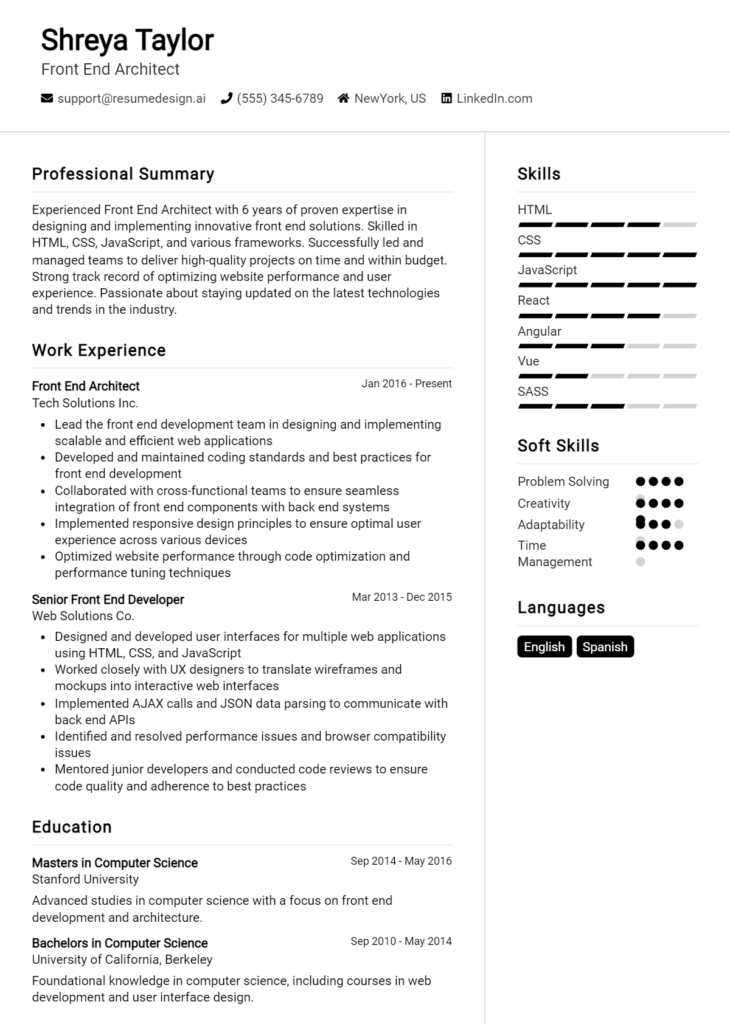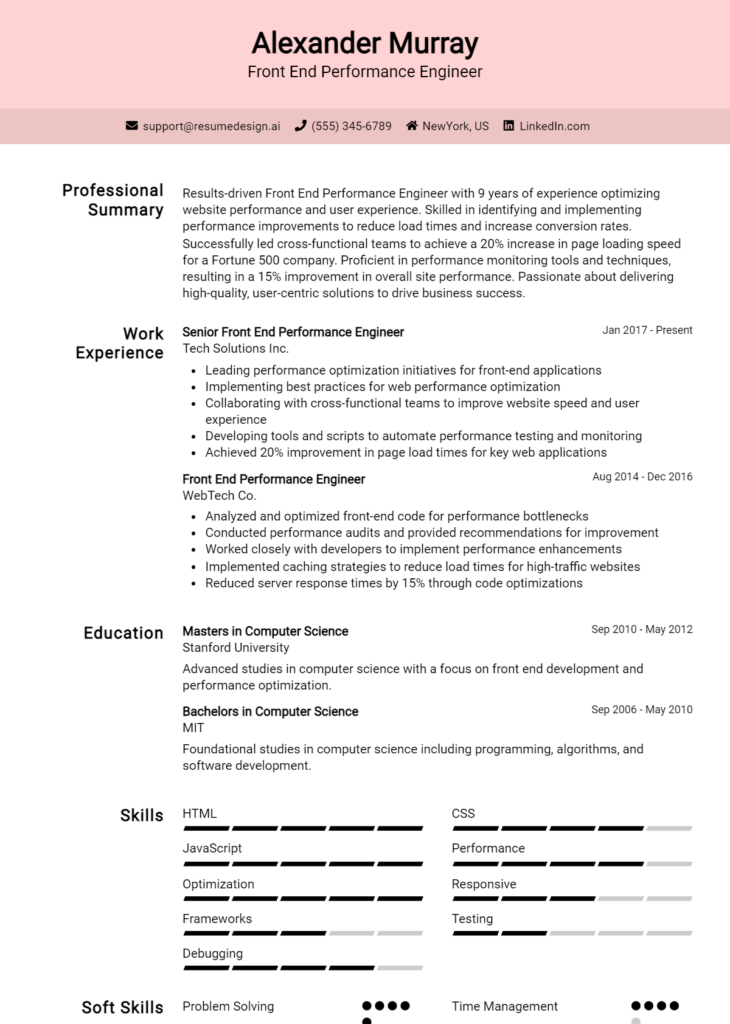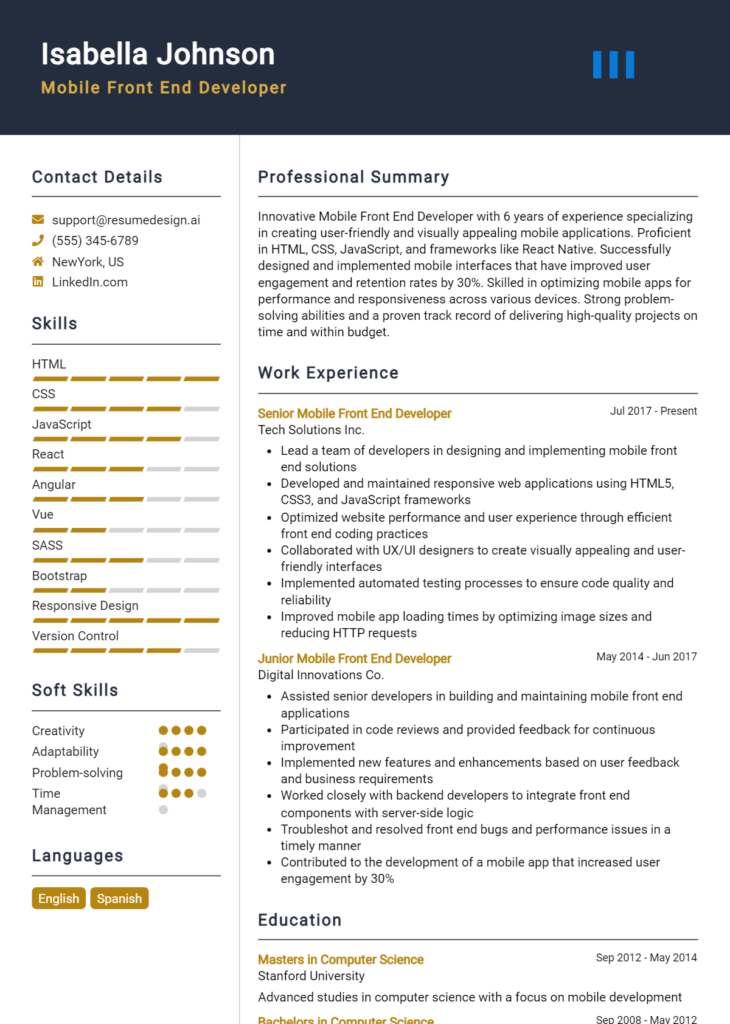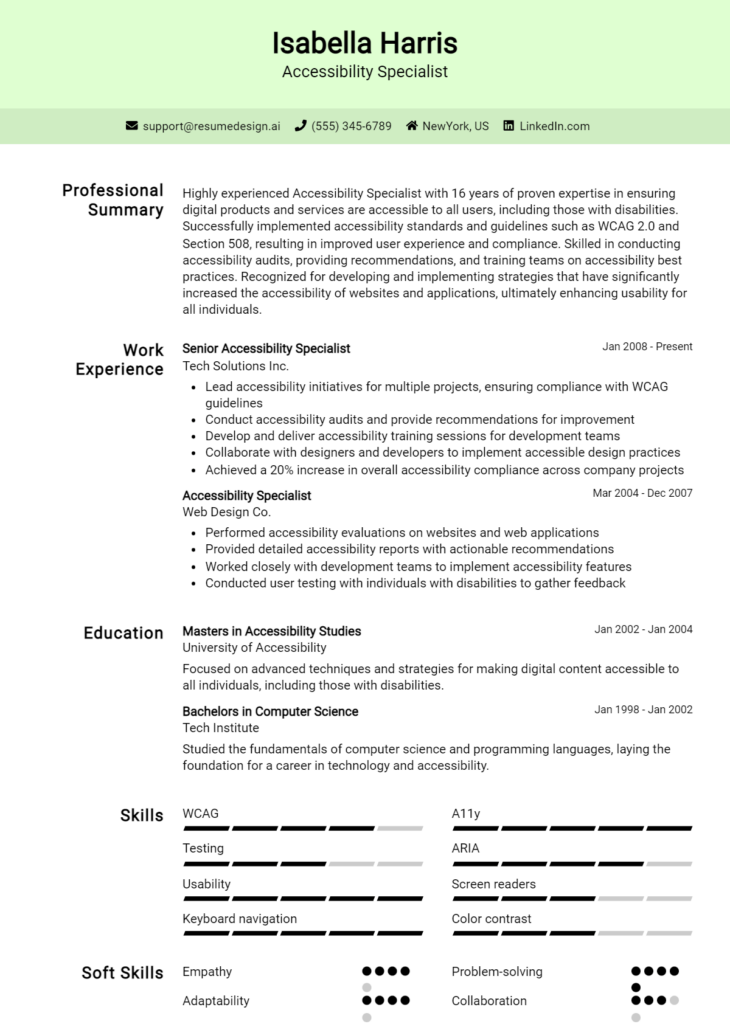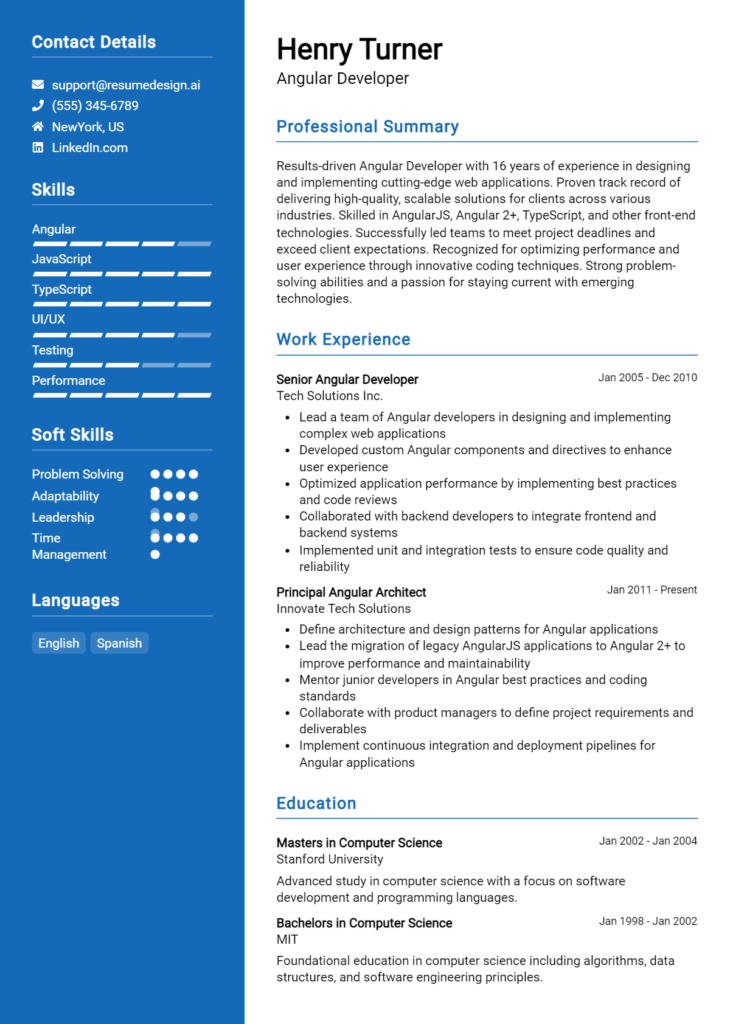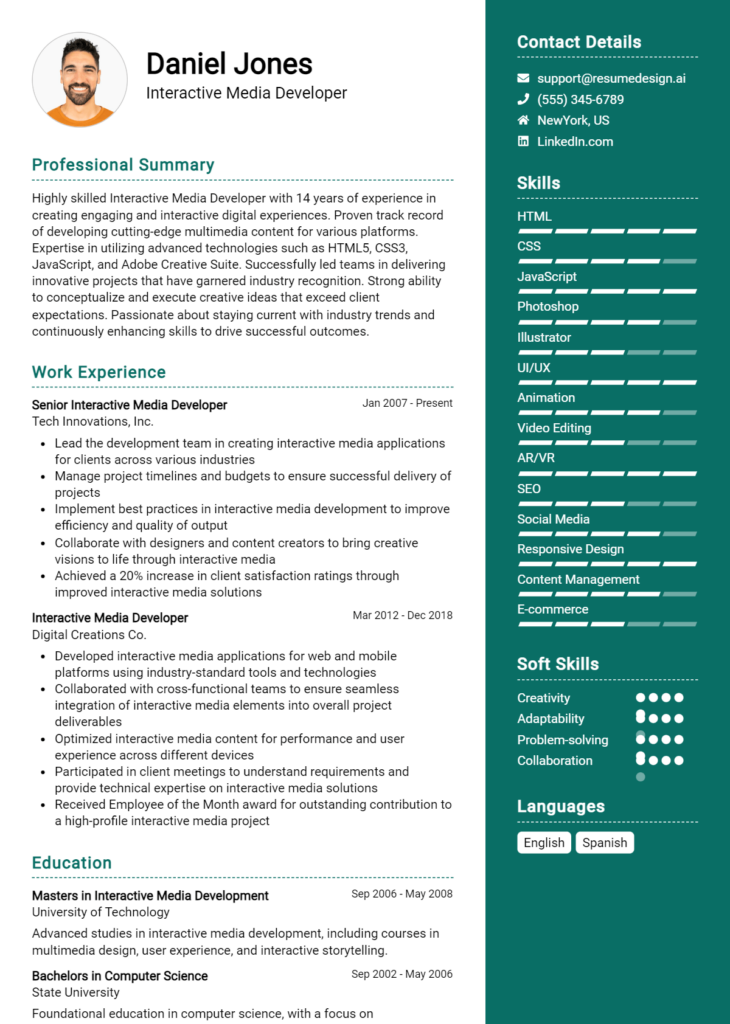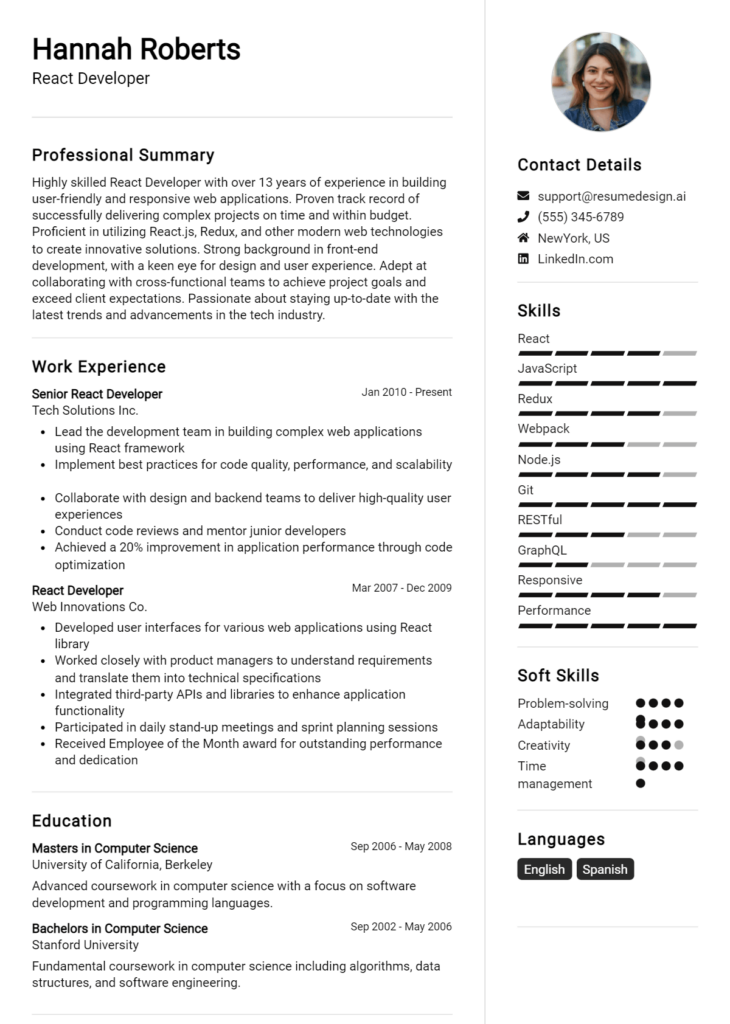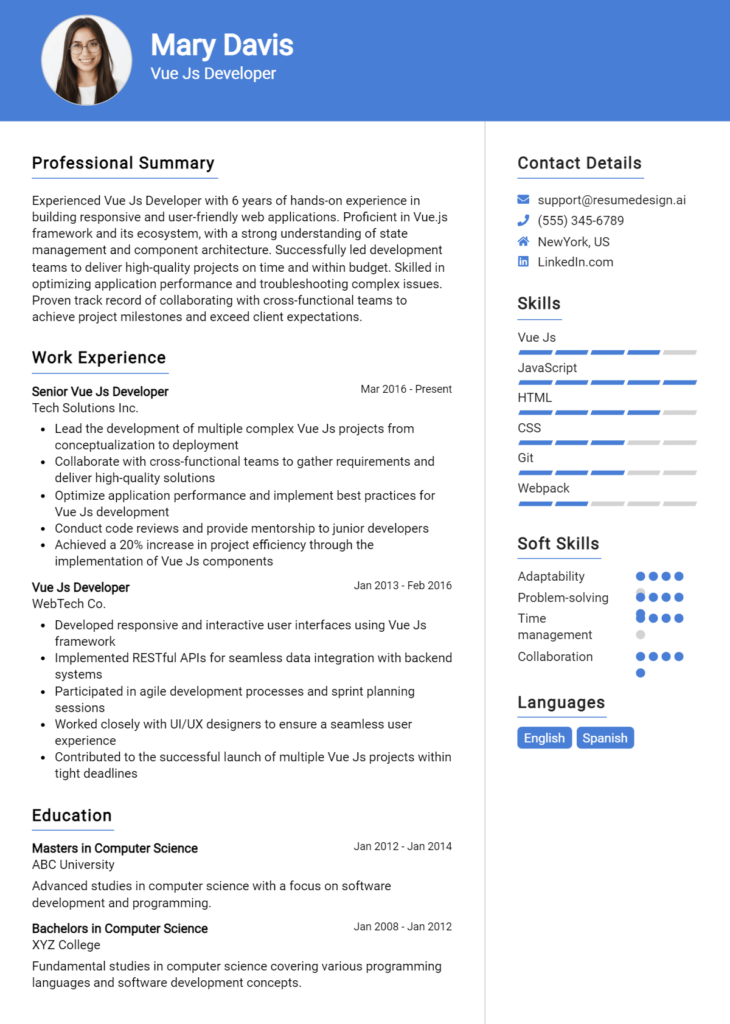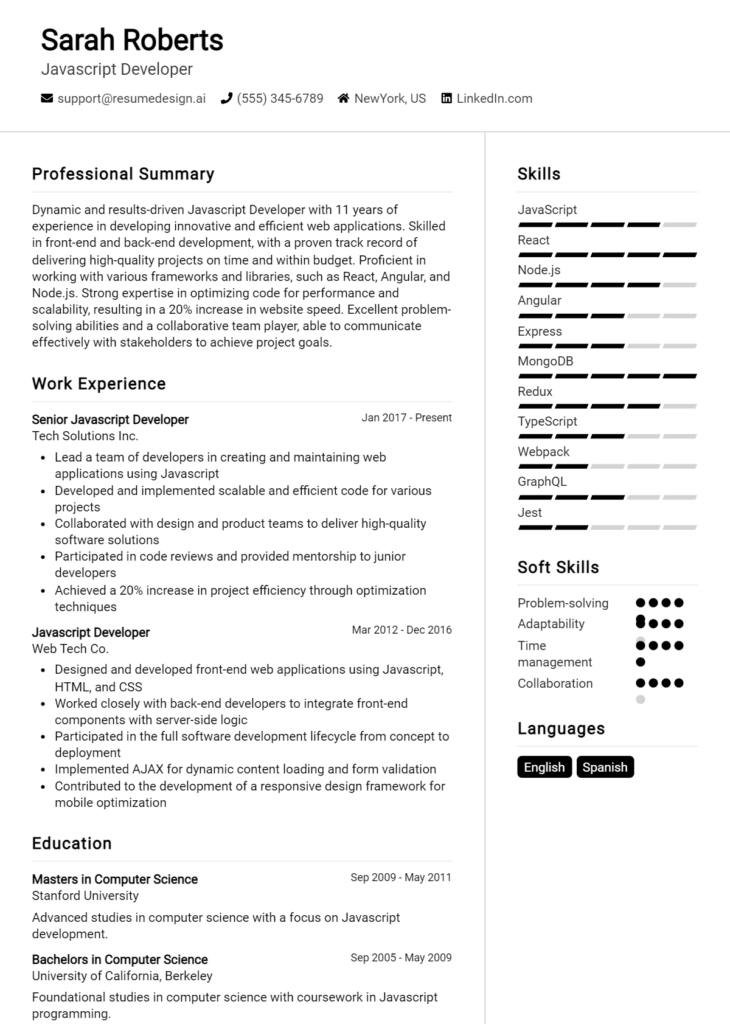Web Designer Core Responsibilities
A Web Designer plays a pivotal role in creating visually appealing and user-friendly websites that align with an organization's objectives. Key responsibilities include designing layouts, ensuring responsive design, and collaborating with developers and marketing teams to enhance user experience. Essential skills encompass technical expertise in HTML/CSS, operational efficiency in project management, and strong problem-solving abilities to address design challenges. A well-structured resume effectively highlights these qualifications, showcasing the designer's impact on the organization’s overall goals.
Common Responsibilities Listed on Web Designer Resume
- Developing website layout and user interface using HTML/CSS
- Creating and maintaining design standards and style guides
- Collaborating with developers to integrate backend functionality
- Optimizing web pages for maximum speed and scalability
- Conducting user research and usability testing
- Implementing responsive design for various devices
- Managing project timelines and deliverables
- Staying updated on industry trends and technologies
- Creating wireframes, prototypes, and mockups
- Ensuring cross-browser compatibility
- Coordinating with marketing teams for branding consistency
- Maintaining website content and design updates
High-Level Resume Tips for Web Designer Professionals
In the competitive landscape of web design, a well-crafted resume is essential for professionals looking to stand out to potential employers. Your resume is often the first impression you make, and it serves as a powerful tool to communicate your skills, achievements, and unique design philosophy. As the digital world continues to evolve, showcasing not just your technical abilities but also your creativity and problem-solving skills is crucial. This guide will provide practical and actionable resume tips specifically tailored for web designer professionals, helping you to create a resume that truly reflects your capabilities and aligns with the demands of the industry.
Top Resume Tips for Web Designer Professionals
- Tailor your resume to match the specific job description, emphasizing relevant experience and skills that align with the employer's needs.
- Start with a strong summary or objective statement that highlights your design philosophy, years of experience, and key achievements.
- Showcase a portfolio link prominently, including examples of your best work that demonstrate a range of skills and styles.
- Quantify your achievements whenever possible, such as mentioning the percentage increase in user engagement due to your designs.
- Highlight industry-specific skills, including proficiency in design software like Adobe Creative Suite, Figma, or Sketch, as well as web technologies like HTML, CSS, and JavaScript.
- Use clear and concise language, focusing on action verbs that convey your impact, such as “developed,” “designed,” or “optimized.”
- Include relevant certifications or courses that showcase your commitment to continuous learning and staying updated with industry trends.
- Keep the design of your resume clean and professional, using typography and layout that reflect your design aesthetic while ensuring readability.
- Incorporate keywords from the job posting to improve your chances of passing through applicant tracking systems (ATS) that many companies use.
By implementing these tips, you can significantly increase your chances of landing a job in the web design field. A resume that effectively showcases your skills, experience, and creativity will not only capture the attention of hiring managers but also position you as a strong candidate ready to contribute to their team and projects.
Why Resume Headlines & Titles are Important for Web Designer
In the competitive field of web design, a well-crafted resume headline or title serves as a critical first impression for potential employers. This brief yet impactful phrase can immediately capture the attention of hiring managers, summarizing a candidate's key qualifications and unique value proposition in just a few words. A strong headline should be concise, relevant, and directly aligned with the job being applied for, effectively setting the tone for the rest of the resume. By providing an immediate insight into the candidate's skills or experience, a compelling headline increases the chances of making a memorable impact on hiring professionals.
Best Practices for Crafting Resume Headlines for Web Designer
- Keep it concise: Aim for a headline that is 5-10 words long.
- Be role-specific: Use keywords that are directly aligned with the web designer position.
- Highlight key strengths: Focus on your most relevant skills or experiences.
- Use action-oriented language: Start with strong verbs to convey dynamism.
- Avoid jargon: Use clear language that is easily understood.
- Tailor to the job description: Customize your headline for each application.
- Include relevant metrics: If applicable, quantify achievements to add credibility.
- Make it impactful: Aim for a headline that resonates with hiring managers.
Example Resume Headlines for Web Designer
Strong Resume Headlines
“Creative Web Designer Specializing in User-Centric Solutions”
“Experienced Front-End Developer with 5 Years in E-commerce Design”
“Innovative Web Designer with Proven SEO Optimization Skills”
Weak Resume Headlines
“Web Designer”
“Looking for a Job in Web Design”
The strong headlines are effective because they not only specify the candidate's skills and experiences but also illustrate a clear value proposition that aligns with the needs of the employer. They convey a sense of professionalism and focus that can entice hiring managers to delve deeper into the resume. In contrast, the weak headlines lack specificity and fail to communicate any unique qualifications or ambitions, ultimately blending into a sea of generic applications that are easily overlooked.
Writing an Exceptional Web Designer Resume Summary
A resume summary is a critical component for a Web Designer, serving as the first impression for hiring managers. A well-crafted summary quickly grabs attention by highlighting key skills, relevant experience, and notable accomplishments that align with the job role. It acts as a powerful marketing tool, allowing candidates to succinctly present their qualifications and set the tone for the rest of the resume. To be effective, this summary should be concise, impactful, and tailored specifically to the job description, ensuring it resonates with potential employers.
Best Practices for Writing a Web Designer Resume Summary
- Quantify Achievements: Use numbers to highlight your impact, such as increased website traffic or improved user engagement.
- Focus on Skills: Emphasize technical and design skills relevant to the role, such as proficiency in HTML, CSS, and Adobe Creative Suite.
- Tailor the Summary: Customize your summary for each job application to reflect the specific requirements and keywords from the job description.
- Showcase Experience: Mention years of experience in web design and any relevant industries you've worked in.
- Highlight Unique Value: Identify what sets you apart from other candidates, such as a unique design philosophy or a specific niche expertise.
- Keep it Concise: Limit your summary to 2-4 sentences to maintain clarity and focus.
- Use Active Language: Employ action verbs to convey confidence and proactivity in your design work.
- Reflect Your Passion: Infuse a sense of enthusiasm for web design to communicate your dedication to the craft.
Example Web Designer Resume Summaries
Strong Resume Summaries
Dynamic Web Designer with over 5 years of experience creating user-friendly websites, achieving a 40% increase in client satisfaction scores. Proficient in HTML, CSS, and JavaScript, with a strong eye for aesthetics and a commitment to responsive design.
Creative Web Designer skilled in Adobe Creative Suite and UX/UI principles, having successfully led a redesign project that boosted site traffic by 60% within 3 months. Proven ability to collaborate with cross-functional teams to deliver exceptional digital experiences.
Results-oriented Web Designer with a track record of delivering compelling, mobile-responsive websites that enhance user engagement by 35%. Expert in SEO best practices and web analytics, ensuring designs not only look great but perform well too.
Weak Resume Summaries
I am a Web Designer with some experience in design and coding. I enjoy working on projects and learning new skills.
Web Designer looking for a job where I can use my skills and contribute to the team.
The strong resume summaries are effective because they quantify results, specify relevant skills, and demonstrate direct relevance to the web designer role. They provide clear examples of past achievements and articulate the candidate's value to potential employers. In contrast, the weak summaries lack detail, fail to present measurable outcomes, and are too generic, making it difficult for hiring managers to gauge the candidate's true capabilities or fit for the position.
Work Experience Section for Web Designer Resume
The work experience section of a Web Designer resume is crucial as it serves as a testament to the candidate's technical skills and their capacity to manage teams while delivering high-quality products. This section provides potential employers with insight into the applicant's practical experience in the industry, showcasing not only what they have accomplished but also how they achieved those results. By quantifying achievements and aligning experiences with industry standards, candidates can illustrate their impact and effectiveness in previous roles, making a compelling case for their candidacy.
Best Practices for Web Designer Work Experience
- Highlight relevant technical skills such as HTML, CSS, JavaScript, and design tools.
- Quantify results by including metrics like increased website traffic, improved loading times, or conversion rates.
- Describe collaborative projects and your role in team dynamics to showcase teamwork ability.
- Use action verbs to convey your contributions and impact clearly.
- Tailor your experiences to align with the specific job description and industry standards.
- Include noteworthy projects, detailing your specific contributions and the technologies used.
- Focus on problem-solving experiences that demonstrate your ability to overcome challenges.
- Keep descriptions concise and relevant to maintain the reader's interest.
Example Work Experiences for Web Designer
Strong Experiences
- Led a team of 5 designers to revamp the company website, resulting in a 40% increase in user engagement and a 25% boost in conversion rates over six months.
- Developed a responsive e-commerce platform that improved mobile traffic by 60%, enhancing user experience through streamlined navigation and faster load times.
- Collaborated with marketing and development teams to create a promotional landing page that generated 1,000+ leads in the first month, utilizing A/B testing for optimization.
- Implemented SEO best practices on multiple client websites, leading to an average increase of 50% in organic search traffic within three months.
Weak Experiences
- Worked on various design projects for clients.
- Assisted in the development of websites.
- Participated in team meetings to discuss design ideas.
- Helped improve website performance.
The examples listed as strong experiences provide clear, quantifiable outcomes that demonstrate the candidate's technical leadership and ability to collaborate effectively. They highlight specific achievements and contributions that have made a measurable impact on past projects. In contrast, the weak experiences lack detail and specificity, failing to convey the candidate's actual skills, contributions, or results, making them less compelling to potential employers.
Education and Certifications Section for Web Designer Resume
The education and certifications section of a Web Designer resume plays a crucial role in showcasing the candidate's academic background and commitment to ongoing professional development. This section not only highlights relevant degrees and specialized training but also emphasizes industry-recognized certifications that validate the candidate's skills and knowledge in web design. By including pertinent coursework and certifications, candidates can greatly enhance their credibility, demonstrating their alignment with the technical demands of the role and their dedication to continuous learning in a rapidly evolving field.
Best Practices for Web Designer Education and Certifications
- Include only relevant degrees and certifications that pertain directly to web design.
- Highlight industry-recognized credentials, such as Adobe Certified Expert (ACE) or Google Mobile Sites Certification.
- List relevant coursework that demonstrates specialized skills, such as UX/UI design or front-end development.
- Provide details about the institutions attended, such as the name and location, to add credibility.
- Include any ongoing education or workshops that showcase a commitment to staying updated in the field.
- Use bullet points for clarity and to make information easy to scan for hiring managers.
- Prioritize the most advanced qualifications to stand out among other candidates.
- Avoid listing unrelated degrees or certifications that do not contribute to the web design skill set.
Example Education and Certifications for Web Designer
Strong Examples
- Bachelor of Arts in Graphic Design, University of California, Los Angeles (UCLA)
- Adobe Certified Expert (ACE) in Photoshop
- Google UX Design Professional Certificate
- Front-End Web Development Bootcamp, General Assembly
Weak Examples
- Bachelor of Science in Biology, University of Florida
- Certificate in Retail Management from a local community college
- Online course in Basic Cooking Skills
- High School Diploma, Graduated in 2010
The examples listed as strong are considered relevant because they directly relate to the skills and knowledge required for a web designer position, showcasing a blend of formal education and industry-recognized certifications. In contrast, the weak examples include degrees and certifications that do not pertain to web design, thus failing to demonstrate the candidate's qualifications for the role. Strong examples indicate a focused educational path that aligns with the job's requirements, while weak examples lack relevance, diminishing the candidate's credibility in the field.
Top Skills & Keywords for Web Designer Resume
In the competitive field of web design, showcasing the right skills on your resume is crucial for capturing the attention of potential employers. A well-crafted resume that highlights both hard and soft skills can significantly enhance your chances of securing an interview and ultimately landing the job. Employers seek candidates who not only possess technical proficiency but also demonstrate creativity, problem-solving abilities, and effective communication skills. By emphasizing your unique skill set, you can convey your value and fit for the role, making it essential to stay updated on the industry standards for web designers. For more insights on effective skills representation, you can delve into this guide on skills and how to best showcase your work experience.
Top Hard & Soft Skills for Web Designer
Soft Skills
- Creativity
- Attention to Detail
- Communication
- Problem-Solving
- Time Management
- Team Collaboration
- Adaptability
- Critical Thinking
- Client Relations
- Empathy
Hard Skills
- HTML & CSS
- JavaScript
- Responsive Design
- Graphic Design Software (e.g., Adobe Photoshop, Illustrator)
- UX/UI Principles
- SEO Best Practices
- Content Management Systems (e.g., WordPress)
- Version Control (e.g., Git)
- Web Performance Optimization
- Wireframing and Prototyping Tools (e.g., Sketch, Figma)
Stand Out with a Winning Web Designer Cover Letter
Dear [Hiring Manager's Name],
I am writing to express my interest in the Web Designer position at [Company Name], as advertised on [where you found the job posting]. With a background in graphic design and a strong focus on user experience, I am confident in my ability to contribute to your team and help create visually appealing and highly functional websites that resonate with your brand's voice. My experience in both front-end development and visual design has equipped me with a well-rounded skill set that I believe would be an asset to your organization.
At my previous role with [Previous Company Name], I had the opportunity to lead the redesign of our corporate website, which resulted in a 30% increase in user engagement and a significant boost in conversion rates. I utilized my proficiency in HTML, CSS, and JavaScript to ensure that the site was not only aesthetically pleasing but also optimized for various devices and screen sizes. Additionally, my familiarity with design tools such as Adobe Creative Suite and Figma allows me to create innovative mockups and prototypes that align with the latest web design trends. I am passionate about creating seamless user experiences, and I am always seeking to enhance my skill set to stay current with industry advancements.
I am particularly drawn to [Company Name] because of [specific reason related to the company or its projects]. I admire your commitment to [specific value or project], and I am eager to bring my creativity and technical expertise to your team. I believe that collaboration and communication are key to successful design projects, and I am excited about the opportunity to work alongside talented professionals who share my passion for exceptional web design.
Thank you for considering my application. I look forward to the possibility of discussing how my skills and experiences align with the needs of your team. Please feel free to reach out to me at [your phone number] or [your email address] to schedule a conversation. I am excited about the chance to contribute to the innovative projects at [Company Name].
Sincerely,
[Your Name]
[Your LinkedIn profile or portfolio link]
Common Mistakes to Avoid in a Web Designer Resume
Crafting a standout resume as a web designer is crucial for making a positive impression on potential employers. However, many candidates fall into common traps that can undermine their qualifications and creativity. Understanding these pitfalls can help you create a more effective resume that showcases your skills and unique design perspective. Here are some mistakes to avoid when writing your web designer resume:
Ignoring Design Principles: A web designer's resume should reflect good design practices. Avoid cluttered layouts, poor use of whitespace, and unprofessional fonts that can detract from your overall presentation.
Lacking Specificity: Vague descriptions of your previous roles can leave hiring managers uninspired. Be specific about your contributions, technologies used, and the impact of your work on the projects you were involved in.
Overloading with Technical Jargon: While it’s important to showcase your skills, using too much technical jargon can alienate recruiters who may not have a design background. Strive for clarity and balance technical terms with layman's descriptions.
Neglecting Tailoring: Sending out a generic resume can hinder your chances of getting noticed. Tailor your resume for each job application by highlighting relevant experiences and skills that align with the job description.
Forgetting to Include a Portfolio: As a web designer, your portfolio is just as important as your resume. Failing to include a link to your portfolio can result in missed opportunities to showcase your work and creativity.
Omitting Soft Skills: Technical skills are vital, but soft skills like communication, teamwork, and problem-solving are equally important. Don’t overlook the importance of highlighting how you collaborate with clients and team members.
Using Passive Language: Using passive language can make your contributions seem less impactful. Use active verbs to describe your experiences and achievements to convey confidence and initiative.
Neglecting to Proofread: Spelling and grammatical errors can undermine your professionalism. Always proofread your resume multiple times, or ask a colleague to review it to ensure it is polished and error-free.
Conclusion
As a web designer, your resume plays a crucial role in showcasing your skills, creativity, and experience to potential employers. Throughout this article, we have discussed the essential elements that should be included in your resume, such as a strong summary statement, a detailed portfolio of your work, relevant skills, and education. We also highlighted the importance of tailoring your resume to meet the specific requirements of each job application and the benefits of using action verbs to describe your experiences.
To make your resume stand out even more, consider utilizing professional tools that can enhance its presentation and effectiveness. Resources like resume templates and resume examples can provide you with inspiration and a solid foundation to build upon. Additionally, using a resume builder can streamline the process, allowing you to create a polished resume quickly and easily. Don't forget the importance of a compelling introduction; cover letter templates can help you craft a message that complements your resume and captures the attention of hiring managers.
Now is the perfect time to review your Web Designer Resume and ensure it reflects your best work. Take advantage of these resources to make a lasting impression in your job search!

